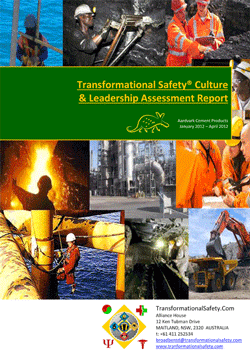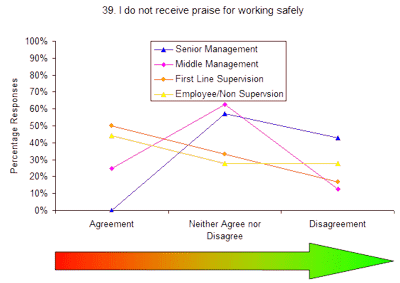
The Integrated Safety Culture Analysis Sample Report
Analysis
Excerpt from the Integrated Transformational Safety® Culture & Leadership Assessment Report.
 What does communication look like at Aardvark Cement Products?
What does communication look like at Aardvark Cement Products?
Safety Communication continues to be recognized as a core predictor within the cultural journey of any business. An organisation may have all the correct policies, procedures etc. It may have the appropriate corporate values, with safety being a core value. All that being said, if the workforce does not recognize these “values” via the internal communication structures, the effectiveness of the overall safety plan is being compromised. The items within the Communication element of the Transformational Safety® Culture Survey aim to provide a balanced appreciation of the workforces’ acknowledgement of the quality of the safety communication within the workplace.
Aardvark Cement Products’s response profile shows an organisation that has a range of communications that the workforce generally recognizes as “working”. To a large degree it is acknowledged that when it comes to safety, there is pretty much an “open door” policy and that safety communication is reasonable. There was a significant level of uncertainty about these factors; although the level of complete disagreement was relatively small.
The level of “praise” or “recognition” for safe work practices is felt to be quite low, with half the workforce suggesting they do not receive any real recognition.
It was also felt by many employees, that supervisors did not always inform them about what was going on around the organisation.
 When we explore the data slicing we find that Employees/Non Supervision and First Line Supervisors are in agreement with respect of praise/ recognition. Almost 50% report a clear lack of praise; when you factor in the “undecided” the observation becomes more powerful.
When we explore the data slicing we find that Employees/Non Supervision and First Line Supervisors are in agreement with respect of praise/ recognition. Almost 50% report a clear lack of praise; when you factor in the “undecided” the observation becomes more powerful.
Within traditional behavioural research we know, with some certainty, that positive reinforcement (which may take the form of praise) has far greater long term impact than the alternative. As we move higher up the organisational tree there is less certainty. It is interesting to observe that almost all employment levels “disagree” to the same proportions. The evident difference is the view expressed by the Senior Management which is almost of an opposing view to the general workforce. Senior management appear to recognize the value of “praise”, and report actually being in receipt of some, although this would not appear to be titrating down to other levels within the organisation. This is a significant observation.
Click Here to download a full copy of The Sample Report.
If you would like to read what the Clinical Excellence Commission says about the measurement of safey culture just Click Here.
” Measuring safety culture can be challenging for a variety of reasons. The expertise needed to carry out technically sound analysis shall likely not exist with current employees. It can be complex to weigh multiple factors simultaneously (i.e. person, behaviour and situation) and there may not be data to readily draw safety culture indicators. Additionally, it is important that there is trust in the results, and that they are used in a practical way. Transformational Safety has successfully implemented safety culture programs across the globe.”

Jamie, Brisbane
![]()
“David Broadbent was asked to conduct a safety culture review of our Council. Almost nine hundred employees across multiple locations. The way he was able to set up his wireless survey tools literally anywhere was pretty impressive. He even ran a data collection session at the sewerage treatment works. This was more than just asking questions. David was able to seamlessly weave in safety education – and you didn’t even notice it happening.”


